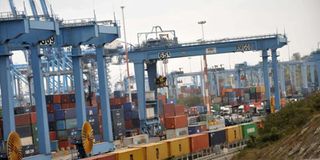Remove bottlenecks to make Kenya a regional logistics hub

The government should boost cargo handling capacity at the Kenya Ports Authority (KPA).
What you need to know:
- Shipping lines and traders require fast, reliable and cost-efficient services to ships and cargo.
- Ports need to continuously invest in their technological, institutional and human capacities.
Investments in infrastructure development and cargo handling have the potential of turning Kenya into a hub for intra-regional trade in Africa.
Transport and logistics are at the core of Kenya’s economic transformation due to the country’s role as a trans-shipment hub for goods moving to landlocked countries in East and Central Africa.
The port of Mombasa is located on international container routes, serving as a well-integrated landing port for regional shipping networks. It connects Burundi, Rwanda and Uganda to overseas markets through dedicated corridors.
Despite the Coast being well positioned as a transshipment site, KPA had over the years restricted the volume of transit cargo to avoid congestion due to limited handling and storage capacities at the port of Mombasa.
Mombasa port has, however, undertaken expansion works that included construction of a new container terminal and dredging to enable bigger vessels access the facility.
The second phase entails construction of the second seaport in Lamu, which is expected to be bigger than the overstretched Mombasa port. Both are expected to help boost Kenya’s status as a transport and logistics hub for the Horn of Africa.
In terms of global rankings, Kenya is placed 71st out of 163 countries on the World Bank’s Logistics Performance Index 2018.
Faster clearance
A 2018 report by the United Nations Conference on Trade and Development (Unctad) on Maritime Transport in Africa notes that the international standard for port dwell time is seven days or less.
However, in East Africa, containers routinely spend more than a week in the terminal. The result is congestion and port inefficiency.
Globally, transshipment businesses have also been simplified to allow faster clearance and approvals using Electronic Data Interchange.
Shipping lines and traders require fast, reliable and cost-efficient services to ships and cargo.
Ports need to continuously invest in their technological, institutional and human capacities. Public and private cooperation is key in this regard.
A faster turnaround time is more appealing to shippers and carriers. Consequently, the number of port calls will be higher compared to a competing port that has a lengthy turnaround time.
The establishment of the Kenya Transport and Logistics Network that brings on board the Kenya Ports Authority (KPA), Kenya Railways Corporation (KRC), the Kenya Pipeline Company (KPC), and the Industrial and Commercial Development Corporation (ICDC) will go a long way in improving trade efficiency.
Enhancing synergy among the four entities will enable the country achieve its goal of bringing this down cargo clearance to under six hours in the near future.





